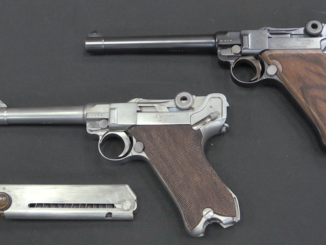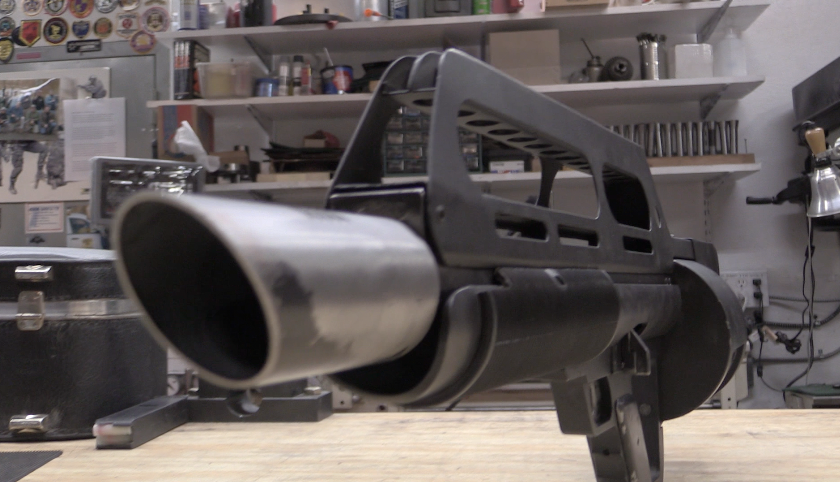This Thompson is being sold at Morphys on October 30.
The first prototype Thompsons submachine guns (and it was Thompson who coined that term, by the way) were produced in 1919 and dubbed the “Annihilators”. The gun was intended to be a military weapon to equip American soldiers in World War One, but by the time the gun was developed the war had ended. Still, Thompson and his Auto-Ordnance company contracted with Colt to manufacture 15,000 of the guns. These were the Model of 1921, and they were marketed to both the US military and as many European armies as Thompson and his salesmen could reach. They found few takers in the climate of the early 1920s, however, and sales were slow.
This is the first in a 5-part series about the development of the Thompson, concluding with a trip to the range to fire three different patterns side by side…




“Keep the change, you filthy animal.”
I’ll just say I enjoyed spraying fools in the game “Guns, Gore, and Cannoli” (and in the sequel) with a Thompson. It strikes me as silly that the wandering soldier zombies armed with Thompson guns still remember how to aim, fire, and reload. “Alright, who’s next, step right up, fifty bullets, no waiting-aha! My next customer!”
Games aside, the Thompson is freakishly heavy and only useful in the context of spraying at close-quarters. Then again, fifty rounds of .45 ACP is not something I’d like to take at point-blank…
““Guns, Gore, and Cannoli””
Well, Thompson sub-machine gun is iconic weapon and thus appeared in numerous video game:
http://www.imfdb.org/wiki/Thompson_M1928#Video_Games_2
“freakishly heavy”
BTW: Why it is so heavy? I understand that loaded L magazine (drum 50) itself must be heavy, but even without that hefty thing, it weight was actually 4,88 kg according to:
http://tankarchives.blogspot.com/2017/09/lend-lease-impressions-submachineguns.html
(data presumably acquired from measurement of actual example)
Fact it fires .45 Auto is not explanation, or can’t be single reason, notice that Ingram Model 6 according to http://www.smallarmsreview.com/display.article.cfm?idarticles=2732
weighted 7.25 pounds (unloaded) meaning ~3,29 kg. Was any special manufacturing technology used to produce Ingram Model 6 which were unknown in 1919?
The Thompson was chambered for .45 ACP solely because it was the then-standard U.S. service pistol caliber.
Having used M1921 and M1928 TSMGs fairly extensively in the past, I’ve always thought that a weapon of that size and mass really deserved a cartridge with better ballistics.
At the time it was being developed, the French were making significant use of Winchester Model 1907 self-loading carbines in .351 Winchester self-loading in trench fighting.
I’ve often thought that the .351 WSL round, with ballistics approximating those of the .45 Winchester Magnum (both delivering about 1350-1400 FPE at the muzzle with 180 to 200 grain bullets, in the same KE range as the 7.62 x 39mm with 150-grain bullets) would have been a much better use of the Thompson’s rather involved engineering.
Given the power and range advantage of the .351 WSL over any handgun cartridge of its day, the combination of it plus the TSMG might have resulted in the arrival of the “assault rifle” on the battlefield two decades ahead of schedule.
cheers
eon
There was attempt at “high-speed” Thompson namely:
https://en.wikipedia.org/wiki/.45_Remington%E2%80%93Thompson
“They found few takers in the climate of the early 1920s, however, and sales were slow.”
It should be noted that situation in Europe after outbreak WWII lead to popularity of Thompson sub-machine gun, as we known today. If not such demand caused by that situation Auto-Ordnance would probably made much less examples than in reality.
The black in the background makes it hard to see the gun. Can you set up your photo gray background?
I have read conflicting things about whether the Thompson can still
function without the Blish “H” piece. Could you still cock it without
the H piece?
There’s a persistent rumor since WW2 along the lines of “British troops threw away their Blish Locks”. Like most rumors no one ever questions why soldiers would be throwing away pieces from the inside of the receiver.
Looking at this old training film however https://www.youtube.com/watch?v=TTFLYTWanxA it doesn’t look like the Blish Lock is required to cock the weapon riding as it does in a slot in the bolt and not connecting any parts.
All that said I would like a definitive answer as well since I don’t have any first hand knowledge of a Tommy gun being fired with the Blish Lock removed.
I think the rumor grew out of the writings of folks like Hatcher who stated that he thought that the lock didn’t serve any purpose and wasn’t necessary to lock the breech but he never advocated throwing the part away.
I think it was in ‘The Gun that Made the Twenties Roar,’ but there was somewhere a notice that Auto Ordinance was still selling off that first run of Colt-made guns right up until 1939.
Correct. Some of the very last of the 15,000 were ordered (though I think, not delivered) by France in 1939 or early 1940.
Ian: Very good description of the function of the Thompson.You stated the seral # was also under the lower section, where the butt stock attaches.It is also stamped in frame,under the fore arm extension,(visable when barrel is removed and fore arm extension is removed.
Sold Only to Those on the Side of Law and Order!
https://vintage-ads.livejournal.com/5520321.html
Ops, this should be reply to LDC post October 6, 2018 at 1:43 pm
Auto-Ordnance placed some very silly ads in their attempts to get the gun sold: illustrations of cowpokes fighting Native Americans bands or Mexican banditos from horseback; I think there were a few police or prison guard sort of ads as well. Police sales only took off in the wake of sales to criminals. The Capone gang bought one of the St. Valentine’s Day Massacre tommy-guns from a hardware store in Indiana. The FBI and Prohibition agents in Chicago were desperate to increase their firepower and purchased Winchester 1907s and Remington Model 8s as well as Thompsons.
Tiny point of detail. The 100-round C drum was offered from the start, along with the 50-round L and the 20-round box, in the first catalogue for the stockless, rear sight-less 1919 model.
Back in the late 1950s, Hunter’s Lodge in Alexandria, VA, was selling casually DEWATed Model 1928A1s for $79.95. I’m still kicking myself for not picking one up, but I was making only 70 bucks a month as a PFC at Ft. Belvoir.
The Ingram Model 6 only bears a passing resemblance to the Thompson. The M6 used a steel tubing and folded metal construction, while the Thompson has parts machined from a solid block of steel. When changing the M6 magazine, care must be used as the mag will easily fit into the well backwards, causing much embarrassment. With the world awash in post war surplus, the Ingram was born out of step with the times.
Ian, you seem very confused, omit several key features, and misrepresent it.. honestly one of the more disappointing reviews..
1. It IS a breech oiler… how could that buffer?
2. The corresponding oil bottle is in the removeable stock. Early ones were nickel plated.
3. There IS a felt buffer, between the halves of the buffer you failed to take apart and properly understand.
Also worth mentioning is how the grip bar is trapping the barrel under tension from unscrewing. They hold each other in.
A complete slew of errors, maybe you’re run down, or getting a bit comfortable. Seeing such misrepresentation of a icon are a bit concerning..
Good to point it out, he’s our favorite guy, but to be honest, from time to time he makes some small factual mistakes in (not a lot of) videos, fortunately comments section takes care of it.
Ian makes a lot of videos and sometimes he makes mistakes. One video a day, weekends included, with all the traveling and research must take a lot of time. Not the easiest way for a smart and and educated guy to make a living.
Years ago I got to handle a Thompson SMG. There was no opportunity for disassembly. I forget which model, it had a horizontal fore grip and side mounted bolt handle, short barrel and no compensator. I do recall being surprised at how heavy it was.
Thanks for this excellent post. It covered a lot of information clearly and concisely.
Re: quibbles above-
Parts list available here shows an oiler and separate part listed as a buffer.
http://www.nfatoys.com/tsmg/web/m1assy.htm
However, illustrations in sect V Disassembly do not show the Blish device.
I look forward to further reviews in this series.
Were there any experimental efforts in making a stamped sheet steel Thompson, as opposed to uber-expensive milling from steel block ?
I suppose it would also make it lighter
Also, I’ve heard of complaints against stock angle, but could not found any web examples of somebody making a new, more straight in line stock, which is kinda disappointing seeing how easy diy-ish mod that would be.
Yes, I know of bizzare looking army tested straight stock with significantly raised sights, but that is another extreme.
The straight line stock of the 1923 is available custom walnut from Dan Block, of thompsonstocks.com. Remember, initially the gun did not feature a stock, and is perhaps an exaggerated afterthought – similar to the Lyman ladder sight and Cutts compensator, both later deemed superfluous. Do remember, the stock is detachable, and rather loose on some examples. Not fixed until the later models.
The complex interior of the 1921-8 Thompson creates manufacturing difficulties, simplified during the M1 revision. The only further known simplification belongs to Doug Richardson of Chattsworth, CA proposing an aluminum extrusion process to create M1 receiver blanks.
“stamped sheet steel Thompson, as opposed to uber-expensive milling from steel block ?”
Not sheet steel, but Savage Arms attempted to create Thompson variant made from heat treated aluminum forgings, which would be both lighter and faster to made that original
http://www.smallarmsreview.com/display.article.cfm?idarticles=1971
Nonetheless they encountered problems which they were unable to solve
Thompson did look at aluminum receiver parts to save weight but they didn’t get too far. They also made some straight stocks without the pistol grip for the British to try out. Very cool looking but they also didn’t get too far.
Please show how the firing pin actuates in the next video. It’s a bit different from most SMGs.
LDC says auto ordinance placed some silly ads showing a Thompson being used to fight off a band of Mexican bandits. I don’t think the people of Columbus New Mexico thought that ad was silly! Mexican bandits were shooting up American towns in 1916 and those memories were fresh at the time that ad was written.
By the way: why different the connection of the drum and the stick magazines? It is only different due to the heavier weight of the drum magazine?
The Ultimate Thompson Book by Tracie L. Hill lists this as shipping dated 4/1-4/8/1922 sold to the Union Co Sheriffs Department, Marysville, Ohio.
From france.
this modele is not a 1921; it’s a 1921/1928.
I have a original 1921 , this difference is a cutt. 1921 as not cutt.
claude from france